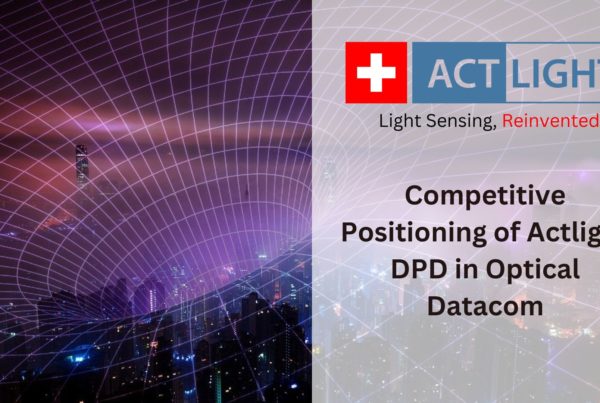The sensor market is a dynamic and ever-evolving landscape. It underpins countless technological advancements, from the smartphones in our pockets to the wearables monitoring our health. However, navigating this landscape can be challenging, particularly when it comes to intellectual property (IP).
A Sea of Sensors, a Shortage of Security
Traditional light sensor technology is often plagued by a crowded patent landscape. Many existing solutions offer incremental improvements on existing photodiodes, making it difficult for companies to differentiate themselves and ensure their innovations are truly secure. This lack of clear ownership over intellectual property can lead to several issues:
- Uncertainty and Risk: Companies integrating these sensors face uncertainty about potential patent infringement lawsuits. This can stifle innovation and hinder the development of truly groundbreaking products.
- Limited Differentiation: In a crowded market, offering just another “me-too” sensor provides little competitive advantage. Companies need unique, secure solutions to stand out.
- Slower Innovation: The fear of patent infringement can lead to companies playing it safe and focusing on minor improvements rather than taking bold leaps forward.
Pioneering Semiconductor Solutions in the Sensor Market
At ActLight, we believe in the power of secure innovation. Our groundbreaking Dynamic PhotoDetector (DPD) technology represents a paradigm shift in light sensing, offering unmatched performance in areas like sensitivity, power consumption, and size. But what truly sets us apart is our robust patent portfolio.
Why is ActLight’s DPD Technology Unique?
A Revolutionary Approach: Unlike incremental improvements, the DPD is a completely new concept in photodetection. It operates on a fundamentally different principle compared to traditional photodiodes, protected by a strong patent portfolio. This provides our partners with the peace of mind of secure integration.
Deep Dive into DPD Technology
A New Type of Photodetector – the Dynamic PhotoDetector
Traditionally, photodiodes operate at static voltage and incident light intensity is obtained from a relatively weak photocurrent. ActLight introduces a new concept of photodiode operation: the photodiode is used in a dynamic regime where pulsed voltage is applied to it. Thus, the light intensity is defined not by magnitude of the measured photocurrent but by the delay time of appearance of the strong output current with the amplitude independent of the light intensity. This new way of the photodiode operation provides a great improvement of the device performance that brings light sensing to a completely new level.
Semiconductor diodes are the most common type of photodetector. They are widely used in the electronics industry from ambient light sensors to wide bandwidth optical telecommunications systems. The technology of diodes used as photodetectors (photodiodes) was developed long ago, in the 1950s. Apart from the introduction of the PIN photodiode at the end of the same decade, conceptually, nothing changed since that time. A PIN photodiode contains two strongly p- and n-doped regions separated by a weakly doped (or undoped) region. The light-induced carrier generation in the PIN structure was initially investigated by Gartner1 in 1959, paving the way to the widespread use in industrial applications. Since that time all PIN photodiodes operate the same way, which we will call “the static regime”: a constant voltage is applied and the incident light intensity is obtained from the measured photocurrent. So far, to improve characteristics of PIN diodes the research was focused on the geometry optimization and use of new materials. However, the fundamental limitations related to the small output current cannot be resolved within this approach.
In the standard static regime the diode is kept at a fixed voltage. The photocurrent of the device changes proportionally to the rate of absorbed photons. Typically, this photocurrent is rather small, and therefore an external amplifier is generally required, that makes difficult weak light detection and fast sensing. In the real applications an amplifier is the main source of noise at the weak light conditions.
Dynamic vs. Static Operation: A Paradigm Shift:
Traditional photodiodes function in a “static” mode. A constant voltage is applied, and the resulting photocurrent is measured. This approach has limitations, especially in sensitivity. ActLight’s DPD takes a “dynamic” approach. Instead of a constant voltage, a pulsed voltage is applied, and the time it takes for a strong output current to appear is measured. This delay time holds the key – it is directly proportional to the light intensity.
Unveiling the Benefits of DPD:
This innovative approach offers a multitude of advantages over traditional photodiodes:
- Unmatched Sensitivity: The DPD boasts exceptional sensitivity, capturing even the faintest light signals. This is particularly valuable for applications in low-light environments and wearables where precise data acquisition is crucial.
- Low Voltage Operation: The DPD operates efficiently at low voltage, significantly reducing power consumption. This translates to extended battery life for wearable devices, a major concern for consumers.
- Compact Design: The unique design of the DPD makes it incredibly compact. This allows for greater design freedom for manufacturers, enabling the integration of light sensing capabilities into smaller and sleeker devices.
Learn more about the benefits of our Dynamic PhotoDetector.
Beyond Technical Brilliance: The Power of Secure IP
For ActLight, the new concept provides not only technological advantages but also advantages in terms of IP:
“In the general sensor market, it’s difficult to be sure your innovation is truly unique. But ActLight isn’t just improving an existing technology; we’re bringing a totally new concept to the market. ActLight is the only company that has been granted patents in this field”
– Serguei Okhonin, ActLight’s CEO.
This robust patent portfolio offers significant benefits for our partners:
Peace of Mind: By integrating ActLight’s technology, companies gain the confidence of knowing their products are built on a secure foundation with unique intellectual property.
Freedom to Innovate: Secure IP removes the fear of patent infringement, allowing companies to focus on developing groundbreaking applications without inhibitions.
A Catalyst for Progress: A secure and differentiated technology like the DPD empowers the entire industry to push the boundaries of what’s possible in light sensing, accelerating innovation across the board.
Read out whitepaper
Charting the Future of Sensor Technology
As ActLight continues to innovate and collaborate with industry partners, we envision a future where sensor technology is not just about incremental improvements, but about revolutionary breakthroughs. By combining cutting-edge technology with a robust IP portfolio, we are breaking barriers and empowering companies to secure their place at the forefront of innovation in a crowded sensor market.
References:
- Gartner, W.W. Depletion layer photoeffects in Semiconductors. Phys. Rev., 116, 84 (1959).
- Kang, Y. et al. Monolithic germanium/silicon avalanche photodiodes with 340 GHz gain-bandwidth product. Nature Photon. 3, 59–63 (2009).
- Assefa, S., Xia, F. and Vlasov, Y.A. Reinventing germanium avalanche photodetector for nanophotonic on-chip optical interconnects. Nature, 464, 80, (March 2010)
- Zhu, S. et al. Waveguided Ge/Si avalanche photodiode with separate vertical SEG-Ge absorption, lateral Si charge, and multiplication configuration. IEEE Electron Dev.
Feel free to contact our Chief Commercial Officer, Roberto Magnifico , for further details regarding the advantages of the Dynamic PhotoDetector.






